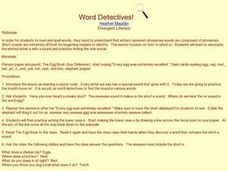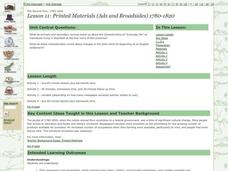Curated OER
Eek, It's a Spider
Students recognize the short vowel e in written and spoken language. Through listening and matching activities, they discriminate the vowel sound /e/ from other phonemes. Students identify the phoneme and letter in words while reading a...
Curated OER
Word Detectives!
Students recognize the short vowel e in written and spoken language. Through matching activities, students discriminate the short vowel e from the long vowel o. They associate the phoneme with its letter representation and identify the...
Curated OER
Appetizing Apples
Students recognize the short vowel a in written and spoken language. Through matching activities, students discriminate the short vowel a from the long vowel a. They associate the phoneme with its letter representation and identify the...
Curated OER
Duh!
Students practice discerning between the letters and sounds for the lower case letters b and d. Through practice activities, they recognize the difference between the commonly confused letters b and d. They practice writing both letters...
Curated OER
The Cat Ate My Apple
Students recognize the phoneme for the short vowel a in written and spoken language. Through a variety of activities, they discriminate the short vowel /a/ from other phonemes. Students associate the phoneme with its letter...
Curated OER
Slithering Snake
Young scholars identify the grapheme and phoneme for S. They practice writing the letter S and through listening activities, discriminate the phoneme /s/. They associate the phoneme /s/ with its letter representation and identify it in...
Curated OER
Aaah, I'm hungry
First graders recognize the short vowel a in written and spoken language. Through matching activities, they discriminate the short vowel /a/ from other phonemes. Students associate the phoneme with its letter representation and spell...
Curated OER
Upper and Lower Case Zz- Printing Practice and Initial Sound Recognition
In this upper and lower case Zz printing practice and initial sound recognition worksheet, students write 1 row of each letter. They follow the directional arrows and dotted lines to form the letters. They print a z next to 7 pictures...
Curated OER
Twain: Icon and Iconoclast
Learners examine work by Mark Twain in the context of pre- and post-Civil War America. In this cross curricular lesson, students gather biographical information about Twain, use a Venn diagram to compare and contrast him with...
Curated OER
Writing With Letters Qq
In this handwriting of uppercase letter Q and lowercase letter q worksheet, students trace twenty two Qq's, print eight sets of Qq's, trace and print the word quilt four times, and trace the sentence at the bottom of the worksheet once.
Curated OER
Recipe: Initial Digraphs R
In this initial digraphs worksheet, students unscramble the phrases that use words with initial r digraphs. Students create a Halloween recipe using the phrases.
Curated OER
Write Your Own Poem 'ill'
In this rhyming words worksheet, students complete four activities that help them learn consonant blend words using the 'ill' sound. Students make rhyming words using the blend, and make a silly sentence and poems with the words.
Curated OER
Write Your Own Poem 'ap'
In this rhyming words worksheet, students complete four activities that help them learn rhyming words containing 'ap.' Students color words that rhyme with cap, pair the rhyming words, make silly sentence with the words and a nonsense poem.
Curated OER
Write Your Own Poem 'ack'
In this rhyming words worksheet, students complete four activities that help them learn words that contain the cluster 'ack.' Students spell words that contain the cluster, write a silly sentence with the words, and then compose two poems.
Curated OER
Match the Words with Pictures Starting with E
In this word recognition worksheet, learners match the 6 words listed to the appropriate pictures. All of the words begin with the letter E. The worksheet may be printed in color or black and white.
Curated OER
Match the Words with Pictures Starting with G
In this word recognition worksheet, students match the 6 words listed to the appropriate pictures. All of the words begin with the letter G. The worksheet may be printed in color or black and white.
Curated OER
Match the Words with Pictures Starting with H
In this word recognition worksheet, students match the 6 words listed to the appropriate pictures. All of the words begin with the letter H. The worksheet may be printed in color or black and white.
Curated OER
Match the Words with Pictures Starting with I
In this word recognition worksheet, students match the 6 words listed to the appropriate pictures. All of the words begin with the letter I. The worksheet may be printed in color or black and white.
Curated OER
Match the Words with Pictures Starting with K
In this word recognition worksheet, learners match the 6 words listed to the appropriate pictures. All of the words begin with the letter K. The worksheet may be printed in color or black and white.
Curated OER
Match the Words with Pictures Starting with M
In this word recognition worksheet, students match the 6 words listed to the appropriate pictures. All of the words begin with the letter M. The worksheet may be printed in color or black and white.
Curated OER
Match the Words with Pictures Starting with O
In this word recognition worksheet, students match the 6 words listed to the appropriate pictures. All of the words begin with the letter O. The worksheet may be printed in color or black and white.
Curated OER
Match the Words with Pictures Starting with P
In this word recognition learning exercise, students match the 6 words listed to the appropriate pictures. All of the words begin with the letter p. The learning exercise may be printed in color or black and white.
Curated OER
Match the Words with Pictures Starting with S
In this word recognition worksheet, students match the 6 words listed to the appropriate pictures. All of the words begin with the letter S. The worksheet may be printed in color or black and white.
Curated OER
Lesson 11: Printed Materials (Ads and Broadsides) 1780-1820
Young scholars use primary resources (gazettes, broadsides, advertisements) to consider life at the turn of the 18th century in Deerfield, Massachusetts. They infer observations about life in the nascent United States.























